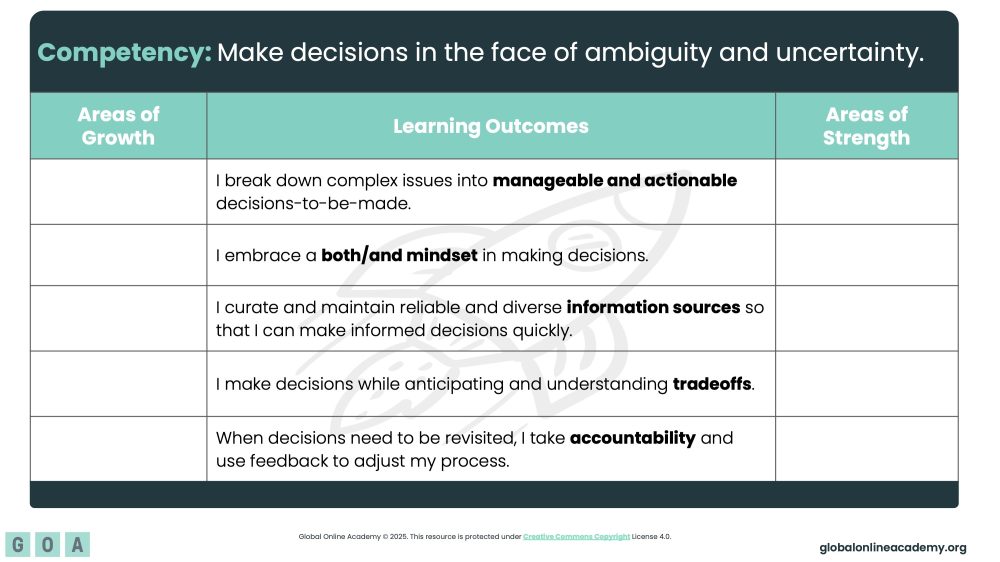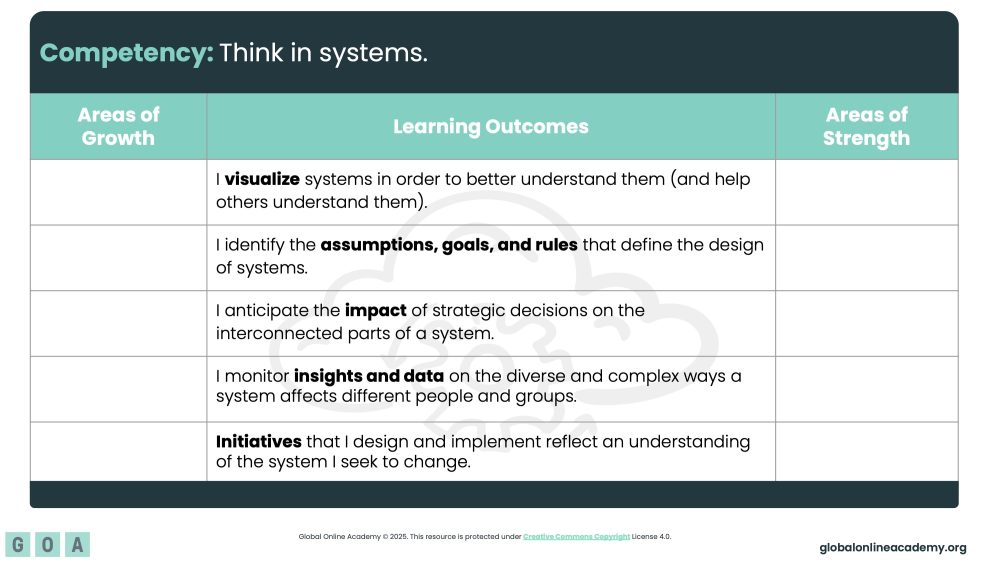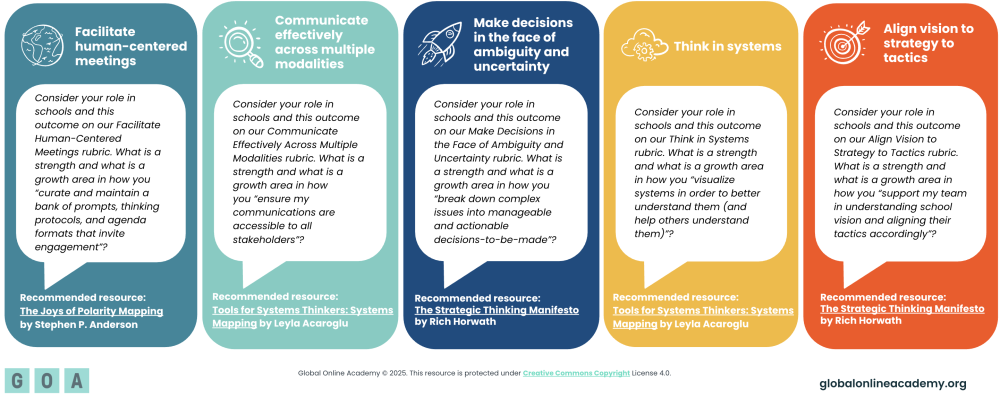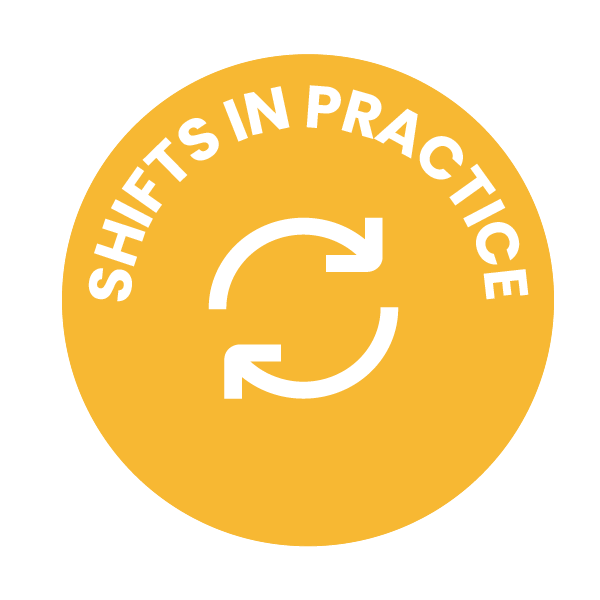Empowering School Leaders: Rubrics for Reflection and Action
At GOA, when we talk of leadership, we hope that word doesn’t evoke titles but instead invites reflection on the actions and stances anyone in schools takes to ensure clarity, foster relationships, and actualize priorities. The practical execution of a school’s mission and vision is in the hands of all school stakeholders. And, it is often the “middle leaders" of our communities—the instructional coaches, division directors, department heads, coordinators—that are tasked with the initiative of bridging the gap between school goals and the daily realities of our students and families.
In 2020, in the midst of global unknowns, GOA engaged in action research to name the skills that emerging and established leaders need. Through our work with over 500 school leaders in leadership institutes, workshops, focus groups, and interviews, we drafted competencies to offer clarity for all leaders seeking to grow and nurture their skill sets.
What developed are five core competencies that are not all-encompassing but are foundational, generative, and iterative. They are designed to provide more than abstract ideals; they offer outcomes and tools for anyone seeking to deepen their leadership skill set. And, this year, we had opportunities to participate in AAIE and NAIS conferences, where we introduced human-centered rubrics aligned to the competencies to promote reflection and action:
Facilitate Human-Centered Meetings

This competency offers look-fors in designing environments and experiences where participants feel safe to speak up and share ideas and where all voices are heard. Deliberate moves to establish psychological safety are central. By designing meetings responsively—carefully considering goals, participants, content, and context—and implementing strategies that promote equitable participation like silent reflection, skillful rounds, and interactive online tools, leaders can invite shared understanding, foster greater clarity, and create spaces where all voices are valued.
Consider your role in schools and this outcome on our Facilitate Human-Centered Meetings rubric. What is a strength and what is a growth area in how you “curate and maintain a bank of prompts, thinking protocols, and agenda formats that invite engagement”?
Recommended resource: Psychological Safety Does Not Equal “Anything Goes” by Amy Edmondson
Communicate Effectively Across Multiple Modalities

Effective communication is an art of intentionality and adaptability. Leaders must develop a sophisticated toolkit that spans diverse communication modes—from video updates to large group presentations. This competency challenges leaders to deeply understand audience needs and craft messages with clarity, accessibility, and timeliness.
Human-centered communication goes beyond mere information transfer—it builds trust, creates meaningful connections, and transforms organizational culture. When leaders communicate with empathy, clarity, and adaptability, they create environments where individuals feel heard, understood, and motivated. This approach breaks down silos, reduces misunderstandings, and empowers team members to engage more deeply with organizational goals and each other's perspectives.
Consider your role in schools and this outcome on our Communicate Effectively Across Multiple Modalities rubric. What is a strength and what is a growth area in how you “ensure my communications are accessible to all stakeholders”?
Recommended resource: The Definition of User Experience (UX) by Don Norman and Jakob Nielsen
Make Decisions in the Face of Ambiguity and Uncertainty

Everyone in schools navigates complex situations where clear solutions are not immediately apparent. Human-centered leadership moves beyond an "either/or" mindset and embraces "both/and" decision-making by recognizing and managing polarities rather than trying to solve them. This means knowing how to break down complex issues, anticipate tradeoffs, and bring understanding to decisions. By leveraging frameworks (like polarity mapping) that invite perspectives and name action-steps, leaders can offer pathways forward amidst uncertainty, supporting their teams through day to day decisions as well as unexpected challenges.
Consider your role in schools and this outcome on our Make Decisions in the Face of Ambiguity and Uncertainty rubric. What is a strength and what is a growth area in how you “break down complex issues into manageable and actionable decisions-to-be-made”?
Recommended resource: The Joys of Polarity Mapping by Stephen P. Anderson
Think in Systems

In complex organizations, understanding both the big picture of initiatives as well as the practical actions is crucial for leaders but also for stakeholders. Leaders adept in systems thinking offer experiences, frameworks, and conversations for understanding how decisions affect communities and where they can be improved and pivoted. By leading others through visualizing processes and projects, leaders and participants can identify assumptions, understand the impact of decisions on others, make unseen work visible, and target areas for meaningful change aligned to school values and priorities.
Consider your role in schools and this outcome on our Think in Systems rubric. What is a strength and what is a growth area in how you “visualize systems in order to better understand them (and help others understand them)”?
Recommended resource: Tools for Systems Thinkers: Systems Mapping by Leyla Acaroglu
Align Vision to Strategy to Tactics

Ideally, the daily actions we take across roles in schools would not only be directly connected to the vision and strategic plans of schools, but every individual would deeply understand their part in that interconnectedness. How vision impacts practical tactics requires clear, purpose-driven communication to define these terms and their relationships, ensuring that all stakeholders know the value and impact of their important work. When equipped with approaches for decoding strategic plans, leaders are uniquely positioned to support communities in making sense of school-wide goals and in naming and living actions that are in direct alignment to core values, missions, and visions.
Consider your role in schools and this outcome on our Align Vision to Strategy to Tactics rubric. What is a strength and what is a growth area in how you “support my team in understanding school vision and aligning their tactics accordingly”?
Recommended resource: The Strategic Thinking Manifesto by Rich Horwath
Take Action

GOA’s leadership stance is one of ongoing iteration and learning, and we welcome opportunities to learn from you and your communities. If you’re interested in more support in implementing the leadership competencies, introducing the rubrics, or engaging your community in human-centered leadership cohorts, please inquire here. We would love to learn with and from you. Additionally, you may download a PDF of the five rubrics to share with your community and to promote action-oriented reflection.
For more, see:
- 2025 Education Trends and Predictions: Pathways, Curiosity, and Co-Creation in a Blended World
- From Correction to Connection: Rethinking Feedback to Empower Students
- What Is the Role of School Leaders in Nurturing Collective Purpose?

This post is part of our Shifts in Practice series, which features educator voices from GOA’s network and seeks to share practical strategies that create shifts in educator practice. Are you an educator interested in submitting an article for potential publication on our Insights blog? If so, please read Contribute Your Voice to Share Shifts in Practice and follow the directions. We look forward to featuring your voice, insights, and ideas.
GOA is a nonprofit learning organization that reimagines learning to empower students and educators worldwide. In partnership with our global network of 150 schools, we provide interactive, relationship-driven courses, expert resources, and innovative thinking that help to expand and elevate academic programs. Together, we help students and educators become open to the extraordinary.
Follow us on LinkedIn for the latest learning opportunities and news. Sign up for GOA Insights, our newsletter focused on innovative ideas and best practices for the future of learning. Become a Member School.

